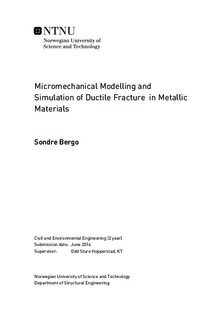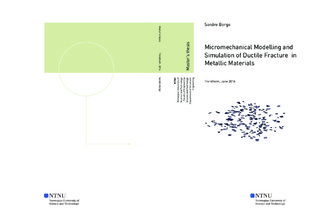| dc.contributor.advisor | Hopperstad, Odd Sture | |
| dc.contributor.author | Bergo, Sondre | |
| dc.date.accessioned | 2019-09-11T08:34:51Z | |
| dc.date.available | 2019-09-11T08:34:51Z | |
| dc.date.created | 2016-06-09 | |
| dc.date.issued | 2016 | |
| dc.identifier | ntnudaim:15082 | |
| dc.identifier.uri | http://hdl.handle.net/11250/2614900 | |
| dc.description.abstract | This thesis is concerned with the modeling of a cellular automaton model of ductile fracture in metals involving significant
micro-structure heterogeneities, based on the growth equations of Rice\&Tracey for the microvoids in metals.
The voids were given an initial size, orientation and position, which means that nucleation and growth were considered
to be two separate phases of ductile growth, and further that all the nucleation was completed at the moment the deformation started. Coalescence was defined to occur at the moment two voids were intersecting each other, and they got replaced by a new minimum volume
enclosing ellipsoid, or with a scaled version of this new ellipsoid, as were thoroughly discussed. Elastic deformations were neglected. The ductility was defined as the value of the equivalent (plastic) strain at a given critical void volume fraction $V_f^{crit}$. $V_f^{crit}=0.2$ was used in most of this thesis, but it became evident that the exact value of this parameter was of less importance.
Furthermore, it was seen that the probability distribution of the voids' positions introduced a variance into the fracture strain calculated by the model. The choice of probability distribution model will evidently influence the results to a great extent.
Based on results obtained throughout the work with the model, it was concluded that to get converged results towards a physically meaningful value of the fracture strain without calibrating the model with results obtained from experiments, the biggest challenge is consequently to find a probability distribution that manages to generate a physical distribution of the microvoids as found in a given alloy. | en |
| dc.language | eng | |
| dc.publisher | NTNU | |
| dc.subject | Bygg- og miljøteknikk (2-årig), Beregningsmekanikk | en |
| dc.title | Micromechanical Modelling and Simulation of Ductile Fracture in Metallic Materials | en |
| dc.type | Master thesis | en |
| dc.source.pagenumber | 137 | |
| dc.contributor.department | Norges teknisk-naturvitenskapelige universitet, Fakultet for ingeniørvitenskap,Institutt for konstruksjonsteknikk | nb_NO |

